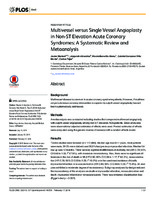Repositorio Digital
Multivessel versus single vessel angioplasty in non-ST elevation acute coronary syndromes: a systematic review and metaanalysis
- DSpace Principal
- →
- Hospital El Cruce
- →
- Publicaciones
- →
- Artículos
- →
- Ver ítem
JavaScript is disabled for your browser. Some features of this site may not work without it.
Mostrar el registro sencillo del ítem
| dc.contributor.author | Mariani, Javier | |
| dc.contributor.author | Macchia, Alejandro | |
| dc.contributor.author | De Abreu, Maximiliano | |
| dc.contributor.author | González Villa Monte, Gabriel | |
| dc.contributor.author | Tajer, Carlos | |
| dc.date.accessioned | 2016-02-24T18:58:43Z | |
| dc.date.available | 2016-02-24T18:58:43Z | |
| dc.date.issued | 2016 | |
| dc.identifier.citation | Mariani J, Macchia A, De Abreu M, Gonzalez Villa Monte G, Tajer C (2016) Multivessel versus Single Vessel Angioplasty in Non-ST Elevation Acute Coronary Syndromes: A Systematic Review and Metaanalysis. PLoS ONE 11(2): e0148756. doi:10.1371/journal.pone.0148756 | es_AR |
| dc.identifier.issn | 1932-6203 | |
| dc.identifier.uri | http://hdl.handle.net/123456789/238 | |
| dc.description | Fil: Mariani, J. Hospital de Alta Complejidad en Red El Cruce Dr. Néstor C. Kirchner. Servicio de Cardiología. Florencio Varela, Argentina. | es_AR |
| dc.description.abstract | Background: Multivessel disease is common in acute coronary syndrome patients. However, if multivessel percutaneous coronary intervention is superior to culprit-vessel angioplasty has not been systematically addressed. Methods: A metaanalysis was conducted including studies that compared multivessel angioplasty with culprit-vessel angioplasty among non-ST elevation ACS patients. Since all studies were observational adjusted estimates of effects were used. Pooled estimates of effects were computed using the generic inverse of variance with a random effects model. Results: Twelve studies were included (n = 117,685). Median age was 64.1 years, most patients were male, 29.3% were diabetic and 36,9% had previous myocardial infarction. Median follow-up was 12 months. There were no significant differences in mortality risk (HR 0.79; 95% CI 0.58 to 1.09; I2 67.9%), with moderate inconsistency. Also, there were no significant differences in the risk of death or MI (HR 0.90; 95% CI 0.69 to 1.17; I2 62.3%), revascularization (HR 0.76; 95% CI 0.55 to 1.05; I2 49.9%) or in the combined incidence of death, myocardial infarction or revascularization (HR 0.83; 95% CI 0.66 to 1.03; I2 70.8%). All analyses exhibited a moderate degree of inconsistency. Subgroup analyses by design reduced the inconsistency of the analyses on death or myocardial infarction, revascularization and death, myocardial infarction or revascularization. There was evidence of publication bias (Egger’s test p = 0.097). Conclusion: Routine multivessel angioplasty in non-ST elevation acute coronary syndrome patients with multivessel disease was not superior to culprit-vessel angioplasty. Randomized controlled trials comparing safety and effectiveness of both strategies in this setting are needed | es_AR |
| dc.language.iso | en_US | es_AR |
| dc.publisher | Public Library of Science (PLOS) | es_AR |
| dc.subject | Angioplastia | es_AR |
| dc.subject | Infarto del Miocardio | es_AR |
| dc.subject | Enfermedad de la Arteria Coronaria | es_AR |
| dc.subject | Análisis Multivariante | es_AR |
| dc.subject | Ensayo Clínico Controlado Aleatorio | es_AR |
| dc.title | Multivessel versus single vessel angioplasty in non-ST elevation acute coronary syndromes: a systematic review and metaanalysis | es_AR |
| dc.type | Article | es_AR |
Ficheros en el ítem
Este ítem aparece en la(s) siguiente(s) colección(ones)
-
Artículos
Articles -
Mariani, Javier

